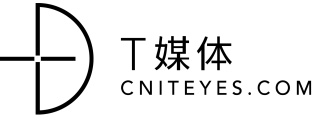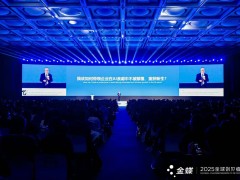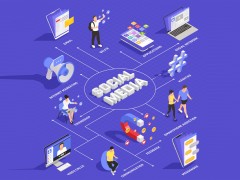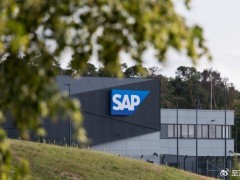SaaS公司的高成长秘诀——聚焦“总流失率”丨双语
原文作者:Ajay Agarwal,Ben Vonwiller 译者:李哲 关键词:SaaS公司,流失率,客户成功 核心提示:衡量客户成功的指标有很多,本文观点认为,总流失率才是影响客户成功的关键性指标。原文作者:Ajay Agarwal,Ben Vonwiller 译者:李哲 关键词:SaaS公司,流失率,客户成功 核心提示:衡量客户成功的指标有很多,本文观点认为,总流失率才是影响客户成功的关键性指标。 衡量客户成功(Customer Success),有很多受人追捧的指标,如净流失率(Net Churn)、总流失率(Gross Churn)、品牌
 衡量客户成功(Customer Success),有很多受人追捧的指标,如净流失率(Net Churn)、总流失率(Gross Churn)、品牌流失率(Logo Churn)、续约率(Renewal Rate)、净推荐值(NPS)等等。
我们研究了SaaSRadar里的一部分公司,以及一些拟上市SaaS公司的麦肯锡数据库。研究结论认为,总流失率是最有影响力的指标。
什么是总流失率?为什么它如此重要?
净流失率是总流失率(代表着现存客户的当前收入流的稳定性)和业务扩张收益(通过对现存客户追加销售或交叉销售产生的收益)的结合体。尽管增长速度快的SaaS公司总流失率低、扩张收益高,但是下图显示,总流失率这一指标比业务扩张收益更重要。
衡量客户成功(Customer Success),有很多受人追捧的指标,如净流失率(Net Churn)、总流失率(Gross Churn)、品牌流失率(Logo Churn)、续约率(Renewal Rate)、净推荐值(NPS)等等。
我们研究了SaaSRadar里的一部分公司,以及一些拟上市SaaS公司的麦肯锡数据库。研究结论认为,总流失率是最有影响力的指标。
什么是总流失率?为什么它如此重要?
净流失率是总流失率(代表着现存客户的当前收入流的稳定性)和业务扩张收益(通过对现存客户追加销售或交叉销售产生的收益)的结合体。尽管增长速度快的SaaS公司总流失率低、扩张收益高,但是下图显示,总流失率这一指标比业务扩张收益更重要。
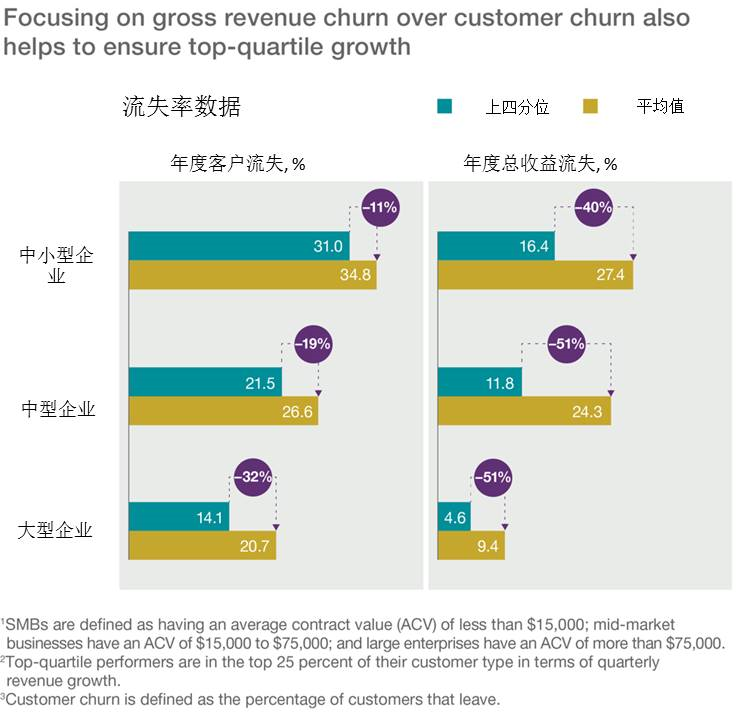 简单地说,高效地维系现存客户和当前收益,比卖给现存客户更多的产品更有效。
例外情况是一些拥有自助式获客模型和基于使用情况的定价模型的公司。因为对于这些公司来说,追加销售不起作用,这就意味着没有销售团队的额外投资。最近上市的Twilio就是一个很好的例子。
快速成长的公司一定要维系好高回报客户,因为总流失率比品牌流失率更关键。
如果你的目标客户是中小企业,那么你面临的挑战之一是,小企业容易倒闭,流失率也会随之上升。如果目标客户是大企业,不存在这一问题。那么,对这两类公司来说,最优的度量指标分别是什么呢?
下图中的数据显示,专注于中小企业的一流公司,年度客户流失率为31%、年度收益率为16%。而专注于大企业的一流公司,年度客户流失率为14%、年度收益率为5%。
简单地说,高效地维系现存客户和当前收益,比卖给现存客户更多的产品更有效。
例外情况是一些拥有自助式获客模型和基于使用情况的定价模型的公司。因为对于这些公司来说,追加销售不起作用,这就意味着没有销售团队的额外投资。最近上市的Twilio就是一个很好的例子。
快速成长的公司一定要维系好高回报客户,因为总流失率比品牌流失率更关键。
如果你的目标客户是中小企业,那么你面临的挑战之一是,小企业容易倒闭,流失率也会随之上升。如果目标客户是大企业,不存在这一问题。那么,对这两类公司来说,最优的度量指标分别是什么呢?
下图中的数据显示,专注于中小企业的一流公司,年度客户流失率为31%、年度收益率为16%。而专注于大企业的一流公司,年度客户流失率为14%、年度收益率为5%。
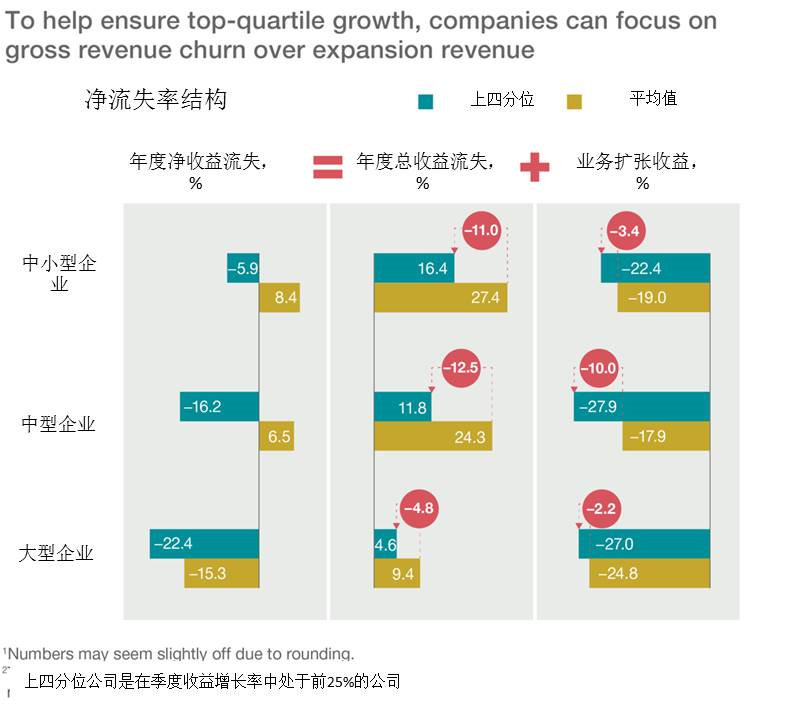 这些数据传达的核心信息是,应该把你的目光聚焦在净流失率,以及更为重要的总流失率上。
上图更深层的含义是,迅速成长的公司致力于维系它们的高回报客户,而不是所有客户。流失一些客户可能没有什么大不了,尤其对于快速发展的初创公司来说,一些早期的客户可能已经不太适合它们今天提供的解决方案了。任何的客户流失都是难以接受的,但是作为一个SaaS CEO,你必须学会接受一些客户的流失,然后对你最重要的客户加倍投入。
以下是减少总流失率的五个建议:
投资建立一个合理规模的客户成功组织。为了降低总流失率,专注于大企业的一流公司投入比客户成功组织的平均全职人工数(FTEs)更多的人力。相反地,专注于中小企业的一流公司,客户成功组织的全职人工数比平均水平低,因为它们可以借助技术和自助服务产品来创造更高效的客户成功和产品入手体验(Onboarding Success)。
不仅要关注技术,更要关注人。最出色的公司都认识到,尽管它们卖的是技术,但最终决定选择续费还是取消服务的,是人。专注于大企业的公司需要清楚执行发起人是谁,然后在发起人离开的时候采取行动。专注于中小企业的公司需要确保它们能定期、自动地与关键买家取得联系。
运用预测模型和指示(Alerting)来提前预测未来的客户成功问题。分析和预测模型可以识别客户流失的驱动因素,优化配置资源,以及指示对高风险、高价值客户的联系策略。
指标,指标,还是指标。三类衡量客户成功的指标需要被持续追踪,即滞后指标(Lagging Indicators)、经济活动指标(Activity Indicators)和领先指标(Leading Indicators)。滞后指标包括续约率和业务扩张指标;经济活动指标包括产品或服务的客户参与度;领先指标包括用户满意度,包括客户的净推荐值(NPS)。
让你的客户成功组织成为公司“学习引擎”。客户成功组织应该把它的研究成果应用到销售、产品和市场团队。这一反馈回路对于整体产品、价值定位和部署模式的改进至关重要。
英文原文:
SaaS entrepreneurs are bombarded with blog posts with an array of metrics and variables on which they need to focus in order to build their companies. Within the world of customer success, there are so many metrics that are touted: gross churn, net churn, logo churn, renewal rates, NPS score, etc.
To better understand which customer success metrics most impact growth, we examined a subset of companies in SaaSRadar, McKinsey’s database of pre-IPO SaaS companies. Our conclusion is that gross churn, by far, is the most impactful metric.
What is gross churn and why does it matter?
Most public SaaS companies report net churn, which represents how your existing customer base is growing or shrinking from one period to the next. Your net churn is a combination of gross churn (how stable is the current revenue stream from existing customers) and expansion revenue (how much additional revenue are you generating from up-sells or cross-sells to your existing customers). While the fastest-growing SaaS companies have low gross churn and do a great job of expansion revenue, the chart below shows that the more important metric of the two is gross churn.
Put simply, if you can more effectively keep the customers/revenue you’ve already signed up — that, on average, has more of an impact than selling more to your existing customers.
The one exception to this rule are companies with self-serve customer acquisition models and usage-based pricing models where up-sells are essentially no touch (meaning no additional investment from the sales team). Twilio, which recently went public, is a good example of this.
High-growth companies make sure to protect their highest-revenue customers: Gross churn matters more than logo churn.
If you are selling to SMBs, one of the challenges you have is that small businesses tend to “go out of business,” which by definition will increase your churn rates. If you are selling to enterprises, you don’t have this problem. So what are the best-in-class metrics for SMB-focused businesses versus enterprise-focused businesses?
The data in the exhibit below shows that the top quartile SMB-focused companies have annual customer churn of 31 percent and annual revenue churn of 16 percent. In contrast, the enterprise-focused companies have annual customer churn rate of 14 percent and revenue churn of 5 percent. The key message here is to benchmark yourself on both net churn but, more importantly, gross churn, from a sample set of companies that are selling to a similar customer base as you, because the best-in-class numbers can vary so wildly.
The further implication is that the fastest-growing companies focus on protecting their highest revenue customers more so than protecting all of their customers. It may be okay to lose some logos — particularly in the evolution of a startup where many early customers may not be a good fit for your solution today. Losing any kind of customer will feel painful, but as a SaaS CEO, you have to be okay with some set of your “off spec” customers churning while you double down on your most important “sweet spot” customers.
Her are five recommendations to reduce gross churn:
Invest in building a right-sized customer success organization. Top performing enterprise-focused companies invest higher than average number of FTEs in customer success in order to drive down gross churn. In contrast, the best-performing SMB-focused companies have fewer FTEs than the average as a result of leveraging technology and self-service products to create a more efficient customer success and onboarding experience.
Focus not just on technology, but on people. The best companies recognize that while they are selling technology, the ultimate decisions to renew or cancel the service are driven by people. Enterprise-focused companies need to ensure they know who the executive sponsor is and take action if that sponsor leaves. SMB-focused companies need to ensure they have regular, automated ways to contact the key buyer within the organization.
Use predictive modeling and alerting to anticipate future success problems in advance. Analytics and predictive modeling can help to identify drivers of churn, prioritize resources and alert contact strategy for customers that are both high-risk and high-value.
Measure, measure, measure. Three categories of customer success metrics should be tracked: lagging indicators, activity indicators and leading indicators. Lagging indicators include metrics such as renewal rate and expansion. Activity indicators include a customer’s engagement in the product or service. Leading indicators include measures of customer satisfaction, such as net promoter score (NPS).
Let your customer success organization be the “learning engine.” Ultimately, the customer success organization cannot live in a vacuum. A strong customer success organization becomes the company’s “learning engine” — relaying their findings from the field to the sales, product and marketing teams. This feedback loop is critical to drive improvements to the overall product, value proposition and delivery model.
本文编译自TechCrunch
原文链接https://techcrunch.com/2016/10/25/to-be-a-top-quartile-saas-grower-you-need-to-focus-on-gross-churn/
这些数据传达的核心信息是,应该把你的目光聚焦在净流失率,以及更为重要的总流失率上。
上图更深层的含义是,迅速成长的公司致力于维系它们的高回报客户,而不是所有客户。流失一些客户可能没有什么大不了,尤其对于快速发展的初创公司来说,一些早期的客户可能已经不太适合它们今天提供的解决方案了。任何的客户流失都是难以接受的,但是作为一个SaaS CEO,你必须学会接受一些客户的流失,然后对你最重要的客户加倍投入。
以下是减少总流失率的五个建议:
投资建立一个合理规模的客户成功组织。为了降低总流失率,专注于大企业的一流公司投入比客户成功组织的平均全职人工数(FTEs)更多的人力。相反地,专注于中小企业的一流公司,客户成功组织的全职人工数比平均水平低,因为它们可以借助技术和自助服务产品来创造更高效的客户成功和产品入手体验(Onboarding Success)。
不仅要关注技术,更要关注人。最出色的公司都认识到,尽管它们卖的是技术,但最终决定选择续费还是取消服务的,是人。专注于大企业的公司需要清楚执行发起人是谁,然后在发起人离开的时候采取行动。专注于中小企业的公司需要确保它们能定期、自动地与关键买家取得联系。
运用预测模型和指示(Alerting)来提前预测未来的客户成功问题。分析和预测模型可以识别客户流失的驱动因素,优化配置资源,以及指示对高风险、高价值客户的联系策略。
指标,指标,还是指标。三类衡量客户成功的指标需要被持续追踪,即滞后指标(Lagging Indicators)、经济活动指标(Activity Indicators)和领先指标(Leading Indicators)。滞后指标包括续约率和业务扩张指标;经济活动指标包括产品或服务的客户参与度;领先指标包括用户满意度,包括客户的净推荐值(NPS)。
让你的客户成功组织成为公司“学习引擎”。客户成功组织应该把它的研究成果应用到销售、产品和市场团队。这一反馈回路对于整体产品、价值定位和部署模式的改进至关重要。
英文原文:
SaaS entrepreneurs are bombarded with blog posts with an array of metrics and variables on which they need to focus in order to build their companies. Within the world of customer success, there are so many metrics that are touted: gross churn, net churn, logo churn, renewal rates, NPS score, etc.
To better understand which customer success metrics most impact growth, we examined a subset of companies in SaaSRadar, McKinsey’s database of pre-IPO SaaS companies. Our conclusion is that gross churn, by far, is the most impactful metric.
What is gross churn and why does it matter?
Most public SaaS companies report net churn, which represents how your existing customer base is growing or shrinking from one period to the next. Your net churn is a combination of gross churn (how stable is the current revenue stream from existing customers) and expansion revenue (how much additional revenue are you generating from up-sells or cross-sells to your existing customers). While the fastest-growing SaaS companies have low gross churn and do a great job of expansion revenue, the chart below shows that the more important metric of the two is gross churn.
Put simply, if you can more effectively keep the customers/revenue you’ve already signed up — that, on average, has more of an impact than selling more to your existing customers.
The one exception to this rule are companies with self-serve customer acquisition models and usage-based pricing models where up-sells are essentially no touch (meaning no additional investment from the sales team). Twilio, which recently went public, is a good example of this.
High-growth companies make sure to protect their highest-revenue customers: Gross churn matters more than logo churn.
If you are selling to SMBs, one of the challenges you have is that small businesses tend to “go out of business,” which by definition will increase your churn rates. If you are selling to enterprises, you don’t have this problem. So what are the best-in-class metrics for SMB-focused businesses versus enterprise-focused businesses?
The data in the exhibit below shows that the top quartile SMB-focused companies have annual customer churn of 31 percent and annual revenue churn of 16 percent. In contrast, the enterprise-focused companies have annual customer churn rate of 14 percent and revenue churn of 5 percent. The key message here is to benchmark yourself on both net churn but, more importantly, gross churn, from a sample set of companies that are selling to a similar customer base as you, because the best-in-class numbers can vary so wildly.
The further implication is that the fastest-growing companies focus on protecting their highest revenue customers more so than protecting all of their customers. It may be okay to lose some logos — particularly in the evolution of a startup where many early customers may not be a good fit for your solution today. Losing any kind of customer will feel painful, but as a SaaS CEO, you have to be okay with some set of your “off spec” customers churning while you double down on your most important “sweet spot” customers.
Her are five recommendations to reduce gross churn:
Invest in building a right-sized customer success organization. Top performing enterprise-focused companies invest higher than average number of FTEs in customer success in order to drive down gross churn. In contrast, the best-performing SMB-focused companies have fewer FTEs than the average as a result of leveraging technology and self-service products to create a more efficient customer success and onboarding experience.
Focus not just on technology, but on people. The best companies recognize that while they are selling technology, the ultimate decisions to renew or cancel the service are driven by people. Enterprise-focused companies need to ensure they know who the executive sponsor is and take action if that sponsor leaves. SMB-focused companies need to ensure they have regular, automated ways to contact the key buyer within the organization.
Use predictive modeling and alerting to anticipate future success problems in advance. Analytics and predictive modeling can help to identify drivers of churn, prioritize resources and alert contact strategy for customers that are both high-risk and high-value.
Measure, measure, measure. Three categories of customer success metrics should be tracked: lagging indicators, activity indicators and leading indicators. Lagging indicators include metrics such as renewal rate and expansion. Activity indicators include a customer’s engagement in the product or service. Leading indicators include measures of customer satisfaction, such as net promoter score (NPS).
Let your customer success organization be the “learning engine.” Ultimately, the customer success organization cannot live in a vacuum. A strong customer success organization becomes the company’s “learning engine” — relaying their findings from the field to the sales, product and marketing teams. This feedback loop is critical to drive improvements to the overall product, value proposition and delivery model.
本文编译自TechCrunch
原文链接https://techcrunch.com/2016/10/25/to-be-a-top-quartile-saas-grower-you-need-to-focus-on-gross-churn/评论
- 暂时没有评论,来说点什么吧
